Ijraset Journal For Research in Applied Science and Engineering Technology
- Home / Ijraset
- On This Page
- Abstract
- Introduction
- Conclusion
- References
- Copyright
Research on Integrated Optimization of Design Parameters and Process Simulation for Throughput Efficiency
Authors: Mr. Jonathan Phiri, Mr. Simbarashe Mamvura, Prof. Zhengshun Fei, Prof. Bingqiang Huang
DOI Link: https://doi.org/10.22214/ijraset.2024.64423
Certificate: View Certificate
Abstract
This thesis presents a comprehensive approach to enhance the production throughput of aluminium bumper beams, a critical component in automotive manufacturing. Using CATIA, an innovative bumper beam design was developed, focusing on simplicity of design and manufacturability. The design parameters considered included material selection, cross-sectional area optimization, and welding techniques to ensure both performance and ease of manufacturing. Transitioning to Tecnomatix Plant Simulation, a virtual environment was constructed to simulate the bumper beam production process. The simulation incorporated the identified design parameters, process routes, layout considerations, and machine arrangements to optimize throughput without inflating costs. By leveraging advanced simulation techniques, the study aimed to identify the most efficient production strategies while maintaining design integrity and minimizing resource consumption. Through systematic scenarios experimentation and analysis, the research yielded insights into the complex relationship between design decisions and manufacturing processes. The results highlight the potential for significant throughput enhancements achievable through collaborative optimization of design and production parameters. The optimization was able to achieve an increase in throughput of about 12.64% of its initial throughput. Moreover, the study underscores the importance of holistic approaches integrating design engineering with manufacturing simulation to drive continuous improvement in industrial operations. This thesis contributes to advancing automotive manufacturing practices by offering a methodology for enhancing production efficiency while preserving product quality and cost-effectiveness. The findings provide valuable guidance for engineers and practitioners seeking to optimize manufacturing processes through the use of simulation and design parameters.
Introduction
I. INTRODUCTION
A. Background and Significance of the Study
Driven by economic growth, technological improvements, and growing living standards, the manufacturing sector has seen a dramatic shift in the age highlighted by China's "Made in China 2025" project. But these advancements have also resulted in problems like excessive energy use, pollution, and fiercer rivalry amongst automakers. Businesses need to improve the effectiveness and quality of their production processes if they want to stay competitive.[1] Under these conditions, it becomes imperative to optimize the lightweight aluminum impact bumper beam production process. Strategic design of production systems, including the optimization of design parameters, process routes, workshop layouts, and scheduling schemes, offers potential to increase throughput without exorbitant investment in new technology. [2]Manufacturers can achieve large throughput increases and processing time reductions by optimizing staff and equipment arrangements, as well as enhancing the structure of production workshops. This thesis looks into how manufacturing efficiency may be increased by optimizing the design parameters and process routes for aluminum bumper beams.
B. Research Purpose
Examining the Significance of Design Parameters: The purpose of this research is to investigate the link that exists between the manufacturing process and the design parameters of aluminum bumper beams. Specifically, the study will concentrate on how differences in design affect manufacturing efficiency and throughput.
Increasing Throughput with Warehouse Optimization: Using Tecnomatix Plant Simulation to optimize production efficiency through better workshop layout configurations is another area of attention for this project. The goal of the study is to determine the optimal design for reducing material handling times and enhancing throughput through experimentation. Combining Design Optimization with Process Simulation: The study integrates process simulation and design optimization to assess the effects of design modifications on manufacturing processes as a whole, resource efficiency, and production performance.
Fig 1 :Manufacturing Process Optimization for Aluminum Bumper Beams:
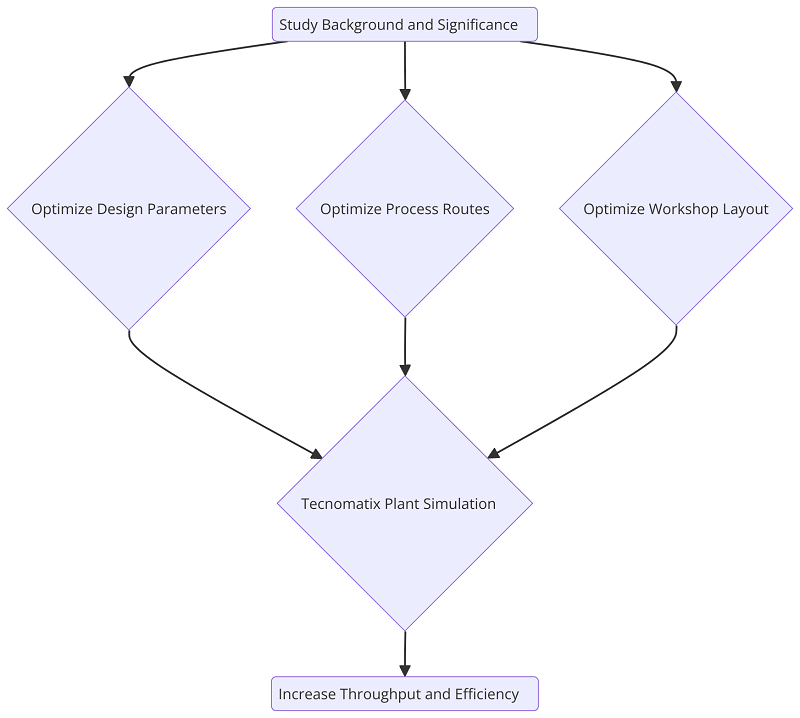
C. Current Status of Domestic and Foreign Research
Current State of Digital Shop Layout: Since the turn of the 20th century, facility planning and workshop design have undergone substantial change. Systematic techniques like Systematic Layout Planning (SLP) have helped increase the productivity of manufacturing plants. Modern shop floor layout optimization has been further improved by digital technologies like Tecnomatix Plant Simulation and cutting-edge techniques like genetic algorithms, which enable manufacturers to model a variety of scenarios and increase throughput while cutting costs. Design parameter problem research status: The automotive industry has recently conducted studies emphasizing the value of optimizing design characteristics, particularly for lightweight aluminum bumper beams.[3] Manufacturers can now create bumper beams that are stronger, lighter, and more affordable thanks to the development of new welding techniques like Friction Stir Welding (FSW) and advanced materials like aluminum alloys from the 6xxx family. Streamlining the manufacturing process and improving product performance are two benefits of optimizing these design parameters.
Current Research Status on Shop Floor Scheduling, Process Routes, and Design Parameter Integration: Design parameter optimization, process route optimization, and shop floor scheduling have historically been handled as independent systems. Recent research, however, supports an integrated strategy that combines these components to raise manufacturing efficiency as a whole. Together, these elements can help manufacturers improve production results, cut down on resource waste, and boost throughput.
II. THEORETICAL FRAMEWORK SECTION
A. Intelligent Manufacturing Systems
The term "intelligent manufacturing systems" (IMS) describes production processes that are flexible, effective, and intelligent by utilizing cutting-edge technology such as automation and data-driven decision-making. To maximize a range of production processes, these systems make use of digital technologies like artificial intelligence (AI), big data analytics, the Internet of Things (IoT), sophisticated robotics, and autonomous systems. IMS aims to improve operations' flexibility, efficiency, and competitiveness by giving robots, systems, and processes the ability to collect and analyze data, make decisions, and collaborate with human operators to get the best results.
To build more flexible and adaptable manufacturing environments, IMS integrates essential elements such resource optimization, autonomous control, data-driven decision-making, and human-machine collaboration. These parts increase productivity and cut down on resource usage while allowing manufacturers to respond to changes and disruptions instantly.
B. Digital Twins
1) Introduction to Digital Twins
The way industries approach production processes has changed dramatically as a result of digital twins. Digital twins are virtual, real-time copies of physical objects, systems, or processes used in the manufacturing industry. Manufacturing processes may be simulated, monitored, and optimized in real time by manufacturers thanks to this dynamic relationship between the digital and physical worlds. This enables for predictive maintenance and offers vital insights into system performance.
2) How Digital Twins Work
Data collection: Information regarding physical manufacturing systems, such as temperature, machine statuses, and production rates, is captured in real-time via sensors and Internet of Things devices. Data Integration: To produce a synchronized representation of the physical system, this data is easily incorporated into the digital model. Analysis and Simulation: This data is analyzed by AI algorithms and advanced analytics to yield insights, and simulations enable the testing of modifications and optimizations.[4] Constant Feedback Loop: Real-time monitoring and decision-making are ensured by a constant flow of data that maintains the Digital Twin in sync with the physical system.
Fig 2 .Digital Twin flow
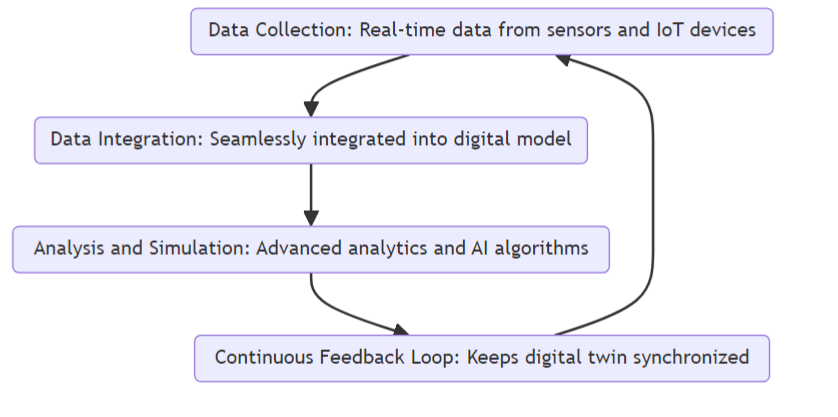
C. Simulation
1) Simulation Introduction and Background
The process of creating a computer-based or mathematical model that simulates the behavior of an actual system is known as simulation. By enabling the observation and analysis of many scenarios, it facilitates decision-making by enabling researchers to duplicate and evaluate complex systems in a controlled environment. Through simulation, engineers and researchers can improve processes, forecast how a system will react to different inputs, and obtain insights into system dynamics.
2) System
When it comes to manufacturing, a "system" is a network of both tangible and intangible components that cooperate to meet predetermined output targets. These components include of orders, information flows, procedures, materials, machinery, and equipment. Interconnected Elements: To accomplish production goals, a manufacturing system's various components work together, either directly or indirectly. Features: These are the distinctive qualities of the system that dictate its functionality and actions. The system's internal activities that translate inputs into intended outputs are referred to as functions.
Fig 3:simulation process
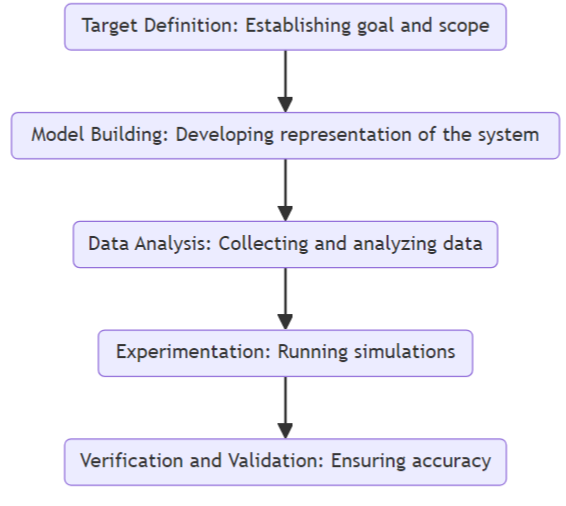
D. Tecnomatix Plant Simulation
A crucial tool for maximizing the throughput of manufacturing plants is Tecnomatix Plant Simulation. With the help of it, users may accurately model production systems and run several scenarios to find the most effective configurations. Tecnomatix's vast library of pre-built items and components is one of its main advantages.[5] A vast array of production tools, workstations, conveyors, and resources are included in this collection, greatly improving user-friendliness and saving important time and resources. These pre-built components may be easily integrated into the simulation model using the plant simulation toolkit, giving customers the freedom to evaluate various setups and scenarios. In addition, Tecnomatix Plant Simulation provides a variety of heuristic techniques, including particle swarm optimization, simulated annealing, and genetic algorithms. Its versatility and adaptability are enhanced by these algorithms, which enable it to address a wide range of production optimization issues. Additionally, the toolkit has included for configurable scripting, multi-objective optimization, and scenario analysis enable experts and academics to customize their approaches to the unique problems encountered by intelligent manufacturing facilities. Manufacturers can test modifications to the manufacturing process, assess performance, and make well-informed decisions to improve throughput and lower operational bottlenecks by leveraging these features. To sum up, Tecnomatix Plant Simulation is a vital tool for increasing throughput in production systems because of its extensive library of pre-built components, integration with optimization engines, and use of heuristic techniques. Tecnomatix Plant Simulation was used in this thesis to test alternative configurations, simulate various production layouts, and optimize the workshop architecture for the manufacturing of aluminum bumper beams.
Fig.4 Plant simulation workbench
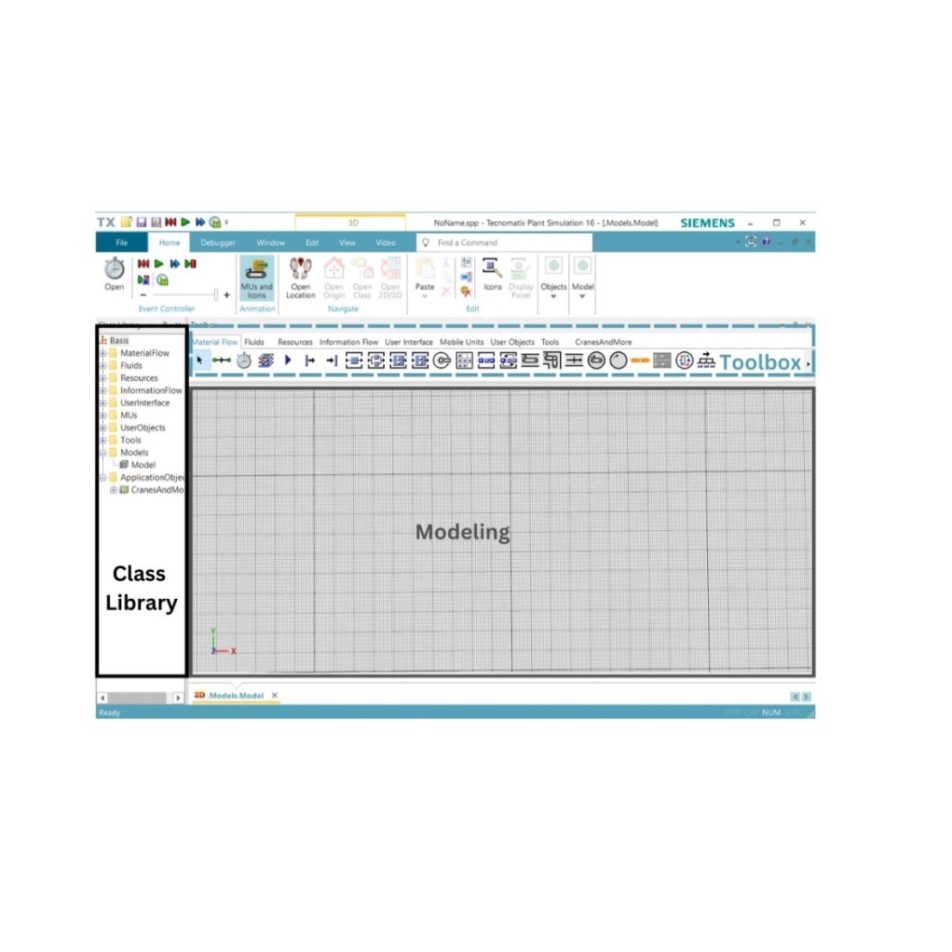
Table2.1 Objects in Plant Simulation
|
Object icon |
Name |
Object icon |
Name |
|
|
Event Controller |
|
Data Table |
|
|
Connector |
|
Method |
|
|
Source |
|
Drain |
|
|
Frame |
|
Variable |
|
|
Buffer |
|
Station |
III. METHODOLOGY AND DATA COLLECTION
A. Introduction to the Methodology
This chapter presents the methodology employed in the investigation of design parameters influencing production time and throughput optimization in aluminium bumper beam manufacturing. The research methodology encompasses the logical approach used to collect important data, analyse findings, and draw conclusions to address the research objectives. Additionally, this chapter outlines the process of data collection, including the selection of variables and machines utilized, as well as the methods employed for data analysis.The primary aim of this study is to explore how various design parameters impact the production time and throughput of aluminium bumper beams, with the ultimate goal of enhancing manufacturing efficiency.[6] To achieve this objective, a multi-faceted research approach was adopted, incorporating both quantitative and qualitative methods. By integrating empirical data with theoretical insights, this research aims to provide comprehensive insights into the complex dynamics of manufacturing processes and warehouse management.The chapter begins with an overview of the research design, outlining the rationale behind the chosen methodology and its alignment with the research objectives. Subsequently, the data collection process is detailed, including the selection of variables, measurement techniques, and data sources. Following this, the chapter moves into the analysis of collected data, presenting the methods employed to interpret the findings and draw meaningful conclusions.Overall, this chapter serves as a critical foundation for understanding the research methodology and data analysis procedures undertaken in this study. By making clear the systematic approach used to investigate design parameters and their impact on production efficiency, it lays the groundwork for the subsequent chapters, which will discuss further the findings and implications of the research.
B. Investigation Method for Simulation
The research methodology is structured to identify critical design parameters influencing production flow efficiency in aluminium bumper beam manufacturing. Drawing on a systematic approach characterized by multiple steps, we aim to pinpoint production bottlenecks and propose prospective modifications for performance enhancement. This involves framing model objectives and requirements, clarifying this paper’s approach, and anticipating outcomes before initiating the simulation process.
Fig 5. Methodology Flow Chart

C. Methodology Flow Description
1) Problem Statement
At the core of our investigation lies a precise problem statement, which guides our simulation study. From our research purpose mentioned in Chapter 1, we have formulated a problem statement tailored to the specific challenges faced in aluminium bumper beam manufacturing. Our objective is to develop a discrete event simulation model of the manufacturing process to improve production flow and throughput efficiency.
2) Theoretical Framework
A comprehensive review of existing literature done in previous Chapters 1 and 2 provides invaluable insights into industry practices and simulation methodologies relevant to the focus of this paper. By synthesizing current research and arguments, we gain a deeper understanding of key concepts and experimental approaches applicable to our study. This literature study serves as a foundation for designing our simulation model and informing our analytical framework.
3) Data Collection and Analysis
Effective data collection is essential for developing and validating our simulation model. We gather a variety of data, including process flow data, cycle time data, resource utilization data, material flow data, and so on. This data collection process informs the construction of our simulation model and ensures its accuracy and reliability. The data collection and analysis techniques will be further discussed in this chapter.
4) Selection of Simulation Software
Choosing the appropriate simulation software is crucial for modelling and analysing the manufacturing process of aluminium bumper beams. After careful evaluation, Siemens Tecnomatix Plant Simulation software was selected for its robust capabilities in modelling, simulating, and optimizing production systems. This software enables us to analyse throughput, identify bottlenecks, and test alternative layouts to improve manufacturing efficiency.
5) Developing the Conceptual Model
The development of a conceptual model is a critical step in designing our simulation experiment. By abstracting key characteristics of the manufacturing process and establishing modelling goals, we create a framework for our simulation model. This conceptual model serves as a blueprint for translating real-world phenomena into a computer-based simulation environment.
6) Model Building
Transforming our conceptual model into a computer-based simulation involves systematic model coding. We use Tecnomatix plant simulation software to build and test our model, ensuring its accuracy and reliability. By iterative coding using stalk and testing our model, we can identify and address potential errors early in the development process and the model is used to do the simulation runs.
7) Model Verification and Validation
Verifying and validating our simulation model is essential for ensuring its accuracy and reliability. Through rigorous verification and validation procedures, we confirm that our model accurately represents the real-world manufacturing process of aluminium bumper beams. This enhances the trustworthiness of our simulation results and facilitates informed decision-making. The model first goes through validation if it doesn't pass as shown in the methodology flow chart, the arrow points back to model building but if it passes it goes through verification to ensure the accurate results are shown.
8) Experimentation
Utilizing our verified simulation model, we conduct experiments to explore various scenarios and identify strategies for improving production efficiency. By analysing simulation outcomes and repeating our model, we gain valuable insights into the factors influencing production throughput and efficiency.
9) Evaluation Methods
The evaluation of our simulation results will be conducted after a series of experiments, the data will be collected and analysed and further optimizations and changes will be done to the model to come up with the best optimal throughput.
10) Documentation
The final stage of our simulation study involves translating our findings into actionable recommendations for implementation in the manufacturing process. By leveraging insights gained from simulation experimentation, we can optimize production flow and enhance efficiency in aluminium bumper beam manufacturing. All the recommendations and findings of the thesis will be documented in the subsequent chapters.
D. Data Collection and Analysis
This section focuses on gathering and analysing the necessary data used for the design and simulation of the aluminium bumper beam production process.To achieve credible results from the simulation study, the accuracy of the simulation is very important. Inaccurate data can lead to unreliable results. In the context of this paper, the collected data is classified into two categories which are qualitative data and quantitative data.
Fig 6 Data collection Flow Chart
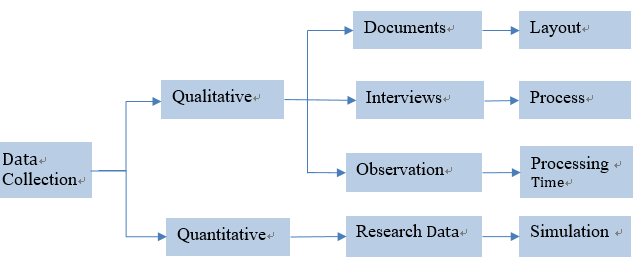
Conclusion
Conclusion on Design Parameter Significance: The complicated relationship between design factors and aluminum bumper beam fabrication provides useful insights. Production KPIs and manufacturability were significantly affected by cross-sectional area and material selection. These implications inform design decisions, improving industrial productivity and efficiency. The study emphasizes design aspects as crucial variables for optimizing production processes and boosting industry competitiveness. Optimizing warehouse layout boosts production efficiency and throughput. Simulated and analyzed layout variants that reduce material handling time, transportation constraints, and workflow efficiency were found in the thesis. After improving the multi-row layout and repositioning machinery, throughput increased. With Tecnomatix Plant Simulation, we can find layout choices that maximize performance. This study emphasizes the importance of strategic layout design in improving output and resource use. Conclusion: In the aluminum bumper beam industry, combining process simulation and design optimization revolutionizes manufacturing efficiency and competitiveness. The study establishes a link between design changes and production processes, enabling informed decision-making. Assessing design changes\' effects on production efficiency and resource utilization shortens product development cycles and boosts industrial competitiveness. This study shows how process simulation and design optimisation can boost manufacturing creativity and productivity.
References
[1] Furian, N., O’Sullivan, M., Walker, C., & Neubacher, D. (2015). A conceptual modeling framework for discrete event simulation using hierarchical control structures. Simulation Modelling Practice and Theory, 56, 82–96. https://doi.org/10.1016/j.simpat.2015.04.004 [2] Haag, S., & Anderl, R. (2018). Digital twin - Proof of concept. Manufacturing Letters, 15, 64-66. https://doi.org/10.1016/j.mfglet.2018.02.006 [3] He, R., Chen, G., Dong, C., Sun, S., & Shen, X. (2019). Data-driven digital twin technology for optimized control in process systems. ISA Transactions, 95, 221–234. https://doi.org/10.1016/j.isatra.2019.05.011 [4] Illmer, B., & Vielhaber, M. (2019). Synchronizing digital process twins between virtual products and resources - A virtual design method. Procedia CIRP, 84, 532-537. https://doi.org/10.1016/j.procir.2019.04.227 [5] Gola, A., & K?osowski, G. (2019). Development of computer-controlled material handling model by means of fuzzy logic and genetic algorithms. Neurocomputing, 338, 381–392. https://doi.org/10.1016/j.neucom.2018.05.125 [6] Wohlfeld, R., Bauernhansl, T., & Riesener, M. (2017). Digital twins for tracking production in Industry 4.0 environments. Advances in Computational Intelligence. https://link.springer.com [7] Gonzalez, C. M. (2020). Robotics Blog: Digital Twins for Robot Installations. American Society of Mechanical Engineers (ASME). https://www.asme.org/topics-resources/content/robotics-blog-digital-twins-for-robot-installations [8] Kenett, R., Zonnenshain, A., & Kenett, D. (2020). Industry 4.0, IoT, and digital twins: Technologies transforming manufacturing. Advances in Computational Intelligence. https://link.springer.com [9] Attaran, M. (2017). The rise of IoT in manufacturing: Technology advancement and its impact on industry. Journal of Manufacturing Systems, 45, 83–96. https://doi.org/10.1016/j.jmsy.2017.10.015 [10] Sepasgozar, S. (2021). Bridging the gap between physical and digital worlds with digital twins. International Journal of Automation and Computing, 18, 1–16. https://doi.org/10.1007/s11633-021-1304-1 [11] Mandolla, C., Petruzzelli, A. M., Percoco, G., & Urbinati, A. (2019). Building a digital twin for industrial automation: The case of the smart factory. Journal of Manufacturing Technology Management, 30(7), 1125-1146. https://doi.org/10.1108/JMTM-09-2018-0327 [12] Gola, A., Pastuszak, Z., & Szwarc, E. (2021). Scalability analysis of selected structures of a reconfigurable manufacturing system. Eksploatacja i Niezawodnosc - Maintenance and Reliability, 23, 242-252. https://doi.org/10.17531/ein.2021.2.10 [13] Jun, S., Lee, S., & Yih, Y. (2020). Pickup and delivery problem with recharging for material handling systems using autonomous mobile robots. European Journal of Operational Research, 284(2), 441-453. https://doi.org/10.1016/j.ejor.2020.07.049 [14] Tao, F., Zhang, M., Liu, Y., & Nee, A. Y. C. (2019). Digital twin in industry: State-of-the-art. IEEE Transactions on Industrial Informatics, 15(4), 2405-2415. https://doi.org/10.1109/TII.2018.2873186 [15] Flaherty, N. (2021). Digital twin combines robot control and VR. Simulation Modelling Practice and Theory, 62, 162-171. https://doi.org/10.1016/j.simpat.2021.05.00
Copyright
Copyright © 2024 Mr. Jonathan Phiri, Mr. Simbarashe Mamvura, Prof. Zhengshun Fei, Prof. Bingqiang Huang. This is an open access article distributed under the Creative Commons Attribution License, which permits unrestricted use, distribution, and reproduction in any medium, provided the original work is properly cited.

Download Paper
Paper Id : IJRASET64423
Publish Date : 2024-09-30
ISSN : 2321-9653
Publisher Name : IJRASET
DOI Link : Click Here
 Submit Paper Online
Submit Paper Online

